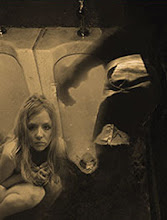 "It's an old building by local standards. John Brown might have ridden past it in a four-in-hand on the northern spur of the Underground Railroad.
"It's an old building by local standards. John Brown might have ridden past it in a four-in-hand on the northern spur of the Underground Railroad.In any other city it would be an archaeological treasure, and a slot for it on the National Register would be someone's cause of the month, but in our town it's just another empty lot in waiting. The corporation that owns it budgets just enough to prevent that, paying an old Russian Jew to bang on the radiators and a crew to sweep out the butts and unclog the waterspouts shaped like griffins. I like it because they let you smoke in the offices.
You can probably sacrifice a goat if you want to badly enough."
-Loren D. Estelman, Poison Blonde (2003)
My city has a lovely reputation. When I travel out of the city and people ask me where I live, I respond by telling them "Detroit." Oh, where near Detroit, they ask? "I live in Detroit," I tell them. There's usually a moment of awkward silence, then they ask, "In the city?" "Yes, in the city," I respond. "Oh" they say, as though I just told them I live in the back room of a circus wagon. Apparently blonde girls don't choose Detroit!
Detroit, its name comes from the French L'Detroit, or the straits, the city of the dire straits. At mid-20th Century Detroit had a population of two million and its industrial might stood unchallenged in the world. Detroiters believed they stood at the crossroads of greatness. They stood at the crossroads alright, but the turn they took was straight down a rutted one-horse-road. The old Coupe de Ville got stuck in a ditch and rusted away in the place it stalled out.
Firestorms of racial tension, insurrectionary riot and labor strife came and went. The once vaunted automobile industry fell victim to globalization and modernization elsewhere and went the way of the Packard, Nash and Hudson. Detroit bled population totals, the fastest shrinking city in history. Over half its people fled in less than fifty years. White flight was followed by black flight. The city's glorious art deco skyscrapers were emptied. A European documentary about the city proved so heartbreaking to French housewives that they sent charity back to L'Detroit as partial repayment for the Marshall Plan. By the time dawn broke, it was over land-based casinos and giveaways to high-tech corporations, last ditch efforts to get the de Ville out of the ditch.
Detroit's current agony involves a sex-texting Mayor, illicit vacationing, and a City credit card account run out of control. Show me a man with a candy red Lincoln Navigator, and I'll show you a dick-less loser every time. The less said about the man, the better. Back in the day, Detroit had a real Mayor. The white folks didn't care much for him much, of course. He let them know that HE was THE MAYOR. Mayor Young was tough, but honest and honorable, more or less. On his desk he had a brass nameplate that read, "Coleman A. Young, MFIC." MFIC, meaning Mutha-Fucker in Charge. They don't make them like Mayor Young anymore.
We've had our share troubles, and more than our share of bad press and forgettable books to go with them. We always turn up in the national papers dubbed as "Murder City. Academics write about Afterculture: Detroit and the Humiliation of History. Funny thing is that even the negative books like Devils Night and Other True Tales of Detroit, and more recently, Made in Detroit, by Paul Clemens,
the anguished memoir of a Detroit ex-pat who isn't quite sure if he's racist or not. Eminem's Crossing Eight Mile, a hit movie, is more a cartoon than genuinely enlightening. Even these negative portrayals of the city admit the power of place the city has on its people, past and present.
Perhaps it is the shared experience of adversity that binds Detroit's remaining 900,000 residents together. Almost all will admit a defensive anger toward the slings and arrows of outsiders that we all must bear. I am not going to lie, as urban problems go, Detroit has more than its fair share. Still, I am and I will remain a "booster!" As America, and the nations beyond America, grow more alike, more homogenized through the forces of fast transportation, communication and economic globalization, many of us will find refuge in our sense of place, no matter where it is. Many will find this sense of home to be strongest in the unique character of older cities like Detroit.
Detroit is still a crossroads. Maybe this is because of the proximity of the deep-water river at the city's front door that runs between Lakes Erie and Huron that brought the French here in the first place. Maybe it is the fact that the city stands on an international border. Maybe it is the mix of black and white that gives the city this character. Even its rusting industrial ruins seem to me a spiritual landscape, frozen between past and future.
In Detroit you can probably sacrifice a goat if you want to badly enough, or do the nasty in the back of an old building. Detroiters have seen too many bad times to be intolerant. Or you might find yourself walking through an ancient arcade toward the open door of a spiritual crossroads you never expected, like a poison blonde on a mission.


No comments:
Post a Comment